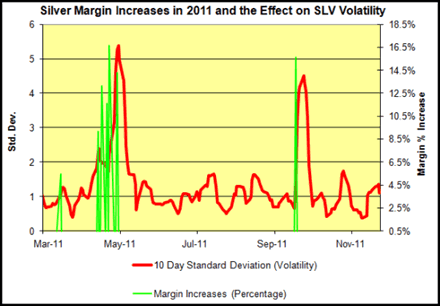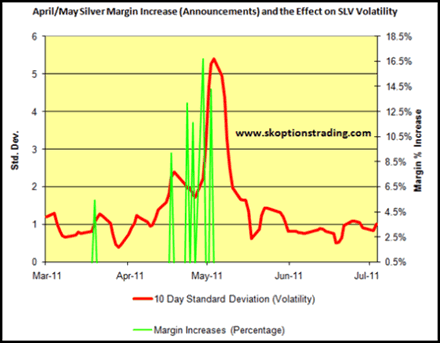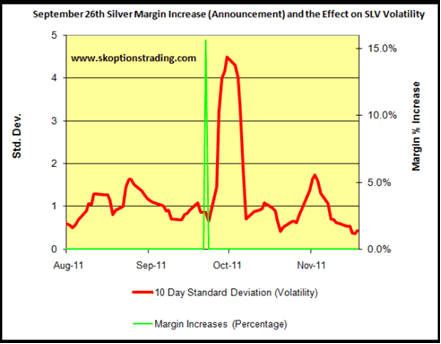Silver Margin Requirements: How the CME System Increases Price Volatility
Commodities / Gold and Silver 2011 Nov 24, 2011 - 02:55 AM GMTBy: Bob_Kirtley
 In this article we investigate the 2011 Chicago Mercantile Exchange (CME) silver margin requirement increases and what effect they have had. Margins necessarily need to rise and fall, to ensure there is minimal default risk in the market, but the system the CME utilizes to achieve this has a lot of room for improvement in our view.
In this article we investigate the 2011 Chicago Mercantile Exchange (CME) silver margin requirement increases and what effect they have had. Margins necessarily need to rise and fall, to ensure there is minimal default risk in the market, but the system the CME utilizes to achieve this has a lot of room for improvement in our view.
The chart below illustrates our main point that the discrete manner in which the CME can change margin requirements for silver futures trading has led to an unnecessary increase in volatility in the silver market. A continuously changing margin system would remove much of this uncertainty and therefore add more credibility to the market.

We will begin by outlining how margins work for trading futures. There are two types of margin; initial and maintenance. When a futures contract is bought, an initial margin is posted by the buyer to the clearing house. The initial margin is a percentage of the total value of the contract and serves to provide a buffer for decreases in the price of the underlying commodity/index. The same process works for when a futures contract is sold.
Assume the initial margin required by a clearing house is $10,000 for a minimum contract size of 50oz of gold at a current price of $2,000/oz – ie, a total contract value of $100,000.
Once the initial margin is posted to the clearing house, the $100,000 contract is bought on behalf of the buyer, $10,000 of which is the buyer’s initial margin, with the other $90,000 coming from the clearing house’s reserves acting as a loan to the buyer giving him leverage of 10:1.
If the price of gold was to fall, and hence the contract’s total value was to decrease, the decrease in the value of the contract is taken directly out of the initial margin posted by the buyer.
Say gold falls by 4% from the initial price of $2,000/oz to $1,920/oz; or a loss in the total value of the contract of $4,000. This $4,000 loss is debited from the contract buyer’s margin account and held by the clearing house.
The clearing house requires a maintenance margin to be held. Assume the maintenance margin in the previous example is set at $5,000. The buyer must maintain a balance in his margin account of at least $5,000. If gold falls by 6% from the original purchase price, and hence the value of the contract falls by $6,000, the margin held in the customers account is now only $4,000. This sum being less than the required maintenance margin of $5,000, the buyer must now deposit a further $1,000 into his margin account to avoid his position being closed out by the clearing house.
When the value of a given futures contract increases, that surplus is deposited into the contract holder’s margin account and the balance rises, over and above the maintenance margin, giving the holder a “buffer zone”.
Margins are required from both the long and short positions of a given futures contract. If the value of a commodity increases, the long side of the contract will receive a payment into their margin account. This payment is funded by the short side of the contract depositing funds into their account to maintain their margin.
The CME is the largest futures and options exchange in the world. The CME dictates margins and can change them with 24 hours notice. Futures contract holders must post further capital into their accounts following an increase in margins (if the capital in their account is less than the new maintenance margin requirement) or have their positions closed.
CME sets margins on a risk adjusted basis. In a volatile market with large price swings occurring each day, margins need to be set high. The CME calculates predicted volatility and ensures that margins are set over and above this to cover any price swings that could occur on a given trading day. When volatility is low, the price stays relatively constant on any given day and margins are consequently lowered.
Margins are overwhelmingly a positive process for the market. We are by no means suggesting that the CME abandon margins or keep the margin requirements fixed. However, the way CME manages their margin requirements can be a cause of much instability and volatility in the market.
Silver is a prime example of this. Silver was trading at record levels in mid to late April. Volatility was at a relatively high, but not unheard of level. The CME acknowledged this rise in volatility and increased margins on April 26th by 9.2% to reflect this.
Traders facing a rise in margins had to free up or find capital with very short notice to avoid having their positions closed. 9.2% wasn’t a huge increase so didn’t have such a profound effect at first. However;
In the 2 week period starting April 26th, margins on one silver futures contract rose from $8,700 to $16,000 in just two weeks – an 84% increase. That is a huge amount of capital for a trader to have to find in such a short space of time. A lot of traders couldn’t and hence there was a huge sell off. The market corrected and as a result silver fell by 28% in around a week.

The above graph plots the iShares silver ETF (iShares tracks the silver price almost to the cent) against Standard Deviation (our best measure of volatility). Standard deviation spikes as soon as the margin requirements are increased (Standard deviation is a lagging indicator by 10 days). This shows the direct impact large increases in margin requirements have.
Effective 26th September 2011, CME increased silver margins by 21%, volatility spiked and the price fell in almost the exact same fashion as the April/May scenario.
The conclusion we can take from this is that, although margin requirements are of significant worth to traders and the market as a whole, the way CME manages them leaves some room for improvement.
When margins are increased by large amounts in short periods of time, this shocks the market. Margins are designed to reduce volatility and risk but what we have seen is the exact opposite.
At the moment, CME watches volatility steadily rise over a month or so, and then increases margins by a corresponding amount to the increased volatility over that month all at once. This shocks the market, as traders have to come up with a lot more capital to keep their positions open. Some can’t and a big sell off ensues.
The graph below shows in closer detail the margin hikes and subsequent increase in volatility in silver during April-May 2011.

Please note that we have plotted the margin changes when they were announced, as opposed to when they were enforced on the market, since the market reacts quickly to margin changes and traders do not wait until they come into effect before beginning to make any necessary adjustments to their positions.
CME’s actions are somewhat of a self fulfilling prophecy or vicious cycle. The CME raises margins to reflect increased volatility, and as a consequence some traders’ positions are closed. This fuels a sell off, increases volatility and requires further margin hikes to reflect the increased volatility and so on and so forth.
The September margin hike is an even more obvious example of a margin hike driving volatility higher.

Whilst the April-May margin hikes were prompted by a massive run up in the silver price, the September hike was not. Furthermore, the CME had not even lowered the margins after the April-May hikes. Why did margins need to be increased 16% further than the levels they were raised to in May, when silver was now trading at a lower price with much lower volatility?
We wrote to our SK OptionTrader subscribers shortly after the margin hikes were announced saying:
We have long said that discretionary changes in margin requirements are a poor way to operate an exchange. They increase uncertainty and volatility in the market. We see no reason why margin requirements could not be adjusted on a daily or weekly basis, based on a pre-determined formula that takes into account the commodity price and current volatility, in order to generate the appropriate margin requirement. Using this process, margins could be adjusted in a continuous and predictable manner and since the formula would be publicly available, all market participants would be able to know with certainty what the margin requirements were going to be for the next trading session.
On top of the fact that the CME does a very poor job of setting margin requirements, market chatter of a CME hike was rampant throughout the Friday, prior to the announcement. Although we are not making any formal accusations, we suspect that information regarding the hike was leaked and those with this information front ran it all day. The system we suggest above would remove any such issues.
A better way of managing the system would be to operate margins on a daily volatility adjusted basis with the use of a simple formula (margins are then managed on a continuous, rather than discrete basis). Margin requirements would therefore be dynamic and one would see daily increases and decreases of no more than 1-2%, rather than big jumps of 10%-25% as seen this year. Traders would be able to post this amount of capital with much greater ease and one would not end up with a huge number of traders all being forced to close their positions at once, leading to huge spikes in prices and volatility – exactly what margins are designed to avoid.
Whether news of the hike was front run on this occasion or not, merely highlights another weakness in the system. The solution isn’t to assure markets that nothing is ever leaked from the CME, the solution is to change the system so that this cannot happen. Simply by publishing a pre-determined formula that dictates margin requirements would solve this. All market participants would know what the margin requirements would be in 24 hours from now with certainty. There would be no margin change shocks to the market.
Furthermore the CME already has systems and formula for setting margin requirements; they do not make discretionary changes by throwing darts at a board. All we are suggesting is make public these systems and adjust the margins on a continuous basis, altering requirements each day.
To stay updated on our market commentary, which gold stocks we are buying and why, please subscribe to The Gold Prices Newsletter, completely FREE of charge. Simply click here and enter your email address. (Winners of the GoldDrivers Stock Picking Competition 2007)
For those readers who are also interested in the silver bull market that is currently unfolding, you may want to subscribe to our Free Silver Prices Newsletter.
DISCLAIMER : Gold Prices makes no guarantee or warranty on the accuracy or completeness of the data provided on this site. Nothing contained herein is intended or shall be deemed to be investment advice, implied or otherwise. This website represents our views and nothing more than that. Always consult your registered advisor to assist you with your investments. We accept no liability for any loss arising from the use of the data contained on this website. We may or may not hold a position in these securities at any given time and reserve the right to buy and sell as we think fit. Bob Kirtley Archive |
© 2005-2022 http://www.MarketOracle.co.uk - The Market Oracle is a FREE Daily Financial Markets Analysis & Forecasting online publication.
Comments
|
John
24 Nov 11, 16:41 |
meddlars
If everybody bought the real thing, ie physical silver, we wouldn't need to worry about the margin manipulation. |



